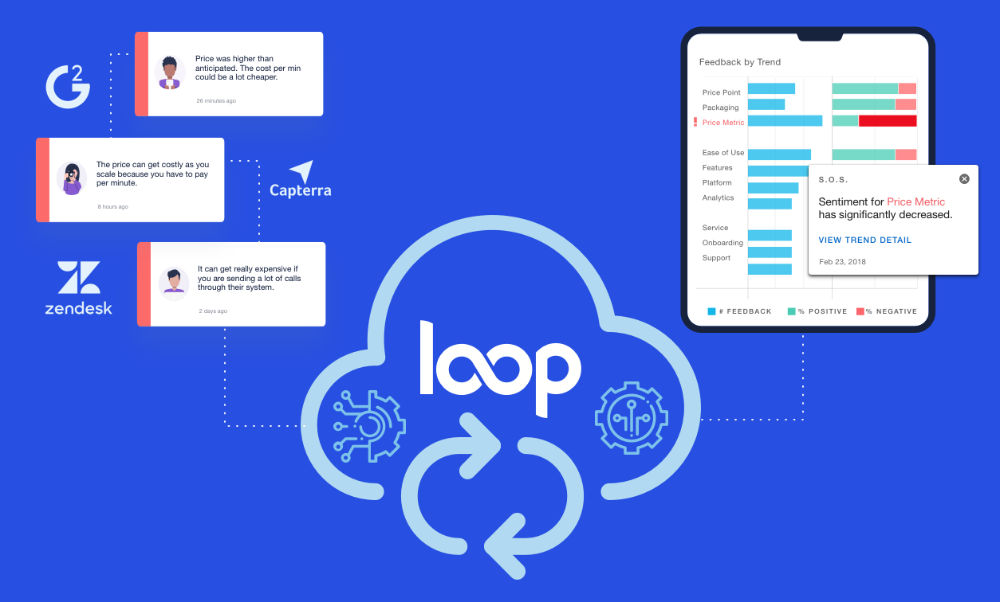Home » Closing the Loop on Voice of Customer Feedback
Closing the Loop on Voice of Customer Feedback
Madeline Turner

We’re all in the process of adapting. We’re pivoting strategies, halting plans, pulling back spend, reallocating resources, and rolling out new resources and offerings. This is all critically important work. Resisting change is not an option if we want to make it through this.
We have to do everything we can to protect revenue, prevent churn, and support our customers and employees through this time.
To do this successfully, it’s important that we are carving out the process and structure to report out on how the actions we’re taking are contributing to goals. This means setting goals, assigning KPIs to each goal, and ensuring that every action roles into a specific goal.
This data is your team’s truth, and it is what should guide your team’s continued adaptation. Staying aligned cross-functionally is both an art and a science. We recommend that teams meet daily or weekly to track progress to goals, actions taken, and the impact of each action. This information should be used to understand what should be stopped, started, or continued.
Here are six tips for measuring progress and impact:
1. Set the KPI for every new initiative and action
If you cannot measure the impact of the work you’re doing, it’s probably not worth doing right now. Every action should be assigned a specific KPI. If you’re rolling out new offers, you wouldn’t measure the success of these offers by measuring retention rates.
If your priority is to retain customers, think about the actions you can take and the KPIs you can measure to track progress.
Example actions:
- Updated pricing for existing customers
- Strategic service support
- Early roll-out of critical features
Example KPIs:
- Number of updated contract agreements
- Requested strategy hours
- Feature adoption
Set target goals for each KPI and track how these are contributing to your ultimate goal of customer retention.
2. Track and report on KPI performance
Track performance frequently. Whether this is daily or weekly, teams should be coming together to report out on the progress to each KPI.
Your team will first want to review the overarching progress to your goals: How is the company performing to customer retention overall? This reminds people of the ultimate goal and aligns everyone on the work left to do.
Next, you’ll dive deeper into the specific impact of each action.
How to structure the updates on your actions:
- KPI for the action
- Percent to completion
- List relevant learnings or updates related to the actions taken or work done to date
Here’s a quick example of how each team/owner can share updates on the progress of each action.

3. Tracking work and actions completed to date
In addition to tracking progress, it’s important to consistently update teams on the work that has been completed since the last update. Especially if you’re working cross-functionally, don’t assume that teams have all of the information or context. Reiterate what’s changed since you last met and what additional efforts have been completed.
This ensures that the team stays aligned on where we were a week or a month ago and where we are now and that we don’t lose sight of actions the team had previously agreed were important.
So many times we collect the info and report it and “talk” about what we want to take action on but time goes by and things never really get the love it deserved even though we all agreed it was an issue – Matthew Arout, Previously at Puppet
Consider creating charts that show actions and work completed over time.
This is also important not just to stay aligned during this time, but to ensure that we are taking time to acknowledge the work that’s being done. These are difficult times. Teams are in the trenches and working harder (and juggling more) than maybe ever before. Celebrate this. Say thank you. Now is a time to have more appreciation and empathy than ever before for your teammates.
4. Know when to reassess
Set a testing period for every action. We recommend 30 days, but this timeframe will differ based on actions taken (some may need more, some may need less).
This is critical to being nimble and staying focused on what works. It also gives everyone on the team guardrails for what to expect (if your testing period is 4 weeks and it’s been one, you have a point of reference for why it’s not time to pause the testing period).
Once your testing period is complete or near complete, you can confidently say that it is time to pivot or pause the approach. In many ways, we’re testing hypotheses right now and looking to our customers to tell us what is and what is not working for them. Embrace the failures and look for the lessons to influence the next step your team takes.
5. Know when it’s time to lean in
If your team sees that a specific action is having a significant impact on your goals, pause to understand what and why it’s working.
Once you understand why something is working, then you can assess whether you continue to let the initiative run or if there is benefit in investing additional resources in the effort.
Does the success of an action point to long term opportunities or strategy shifts? How does this success impact other teams, customers, or prospects?
6. Default to action, not perfection
We need to see results right now. Most of us are not exactly comfortable with “done is better than perfect” but we cannot let this impede us from taking action quickly.
Now is a time to show up and do authentic, customer-focused work. If the strategy is centered on helping customers find value and success in your platform, that’s what is most important. Sometimes, done is good enough – right now is one of those times, especially when it comes to pushing out as much value as possible to our customers.
Launch with your MVP approach and then modify and refine daily as needed.
Everything is weird right now. We have to be more connected than ever despite our separation. Pay attention to customer feedback. Use it to fuel your strategies. Measure the results and stop the things that aren’t bringing value to your customers.
Here’s a reporting template to help your team align on customer feedback and actions contributing to revenue and retention.



